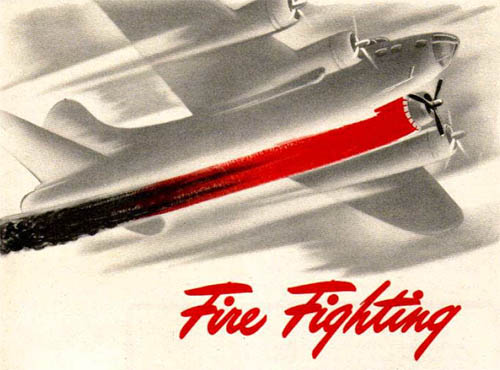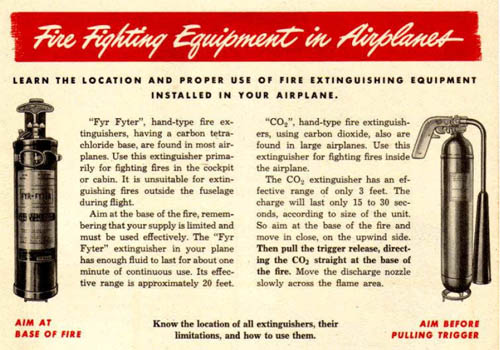Aircraft fire fighting procedures from Pilots’ Information File, U.S. Army Air Forces, 1944:
KNOW THE HAZARDS OF FIRE IN AIRCRAFT—BE FAMILIAR WITH THE PROCEDURE FOR FIGHTING FIRES ON THE GROUND AND IN FLIGHT
IN FLIGHT
Use all fire extinguishers applicable and follow proper procedure at once.
Prepare for emergency. Warn every man on the airplane to attach his parachute and to move to his proper position for bailout.
Determine whether a landing will be attempted or the airplane abandoned.
If airplane is to be abandoned, climb to a safe altitude, if possible, then give the order to bail out.
Engine Fires
At the first sign of a fire, if conditions permit, use the following procedure on the affected engine:
With built-in carbon dioxide system:1. Cowling flaps “OPEN”.
2. Shut fuel “OFF”.
3. Feather propeller.
4. Turn ignition “OFF”.
5. Set extinguisher selector valve.
6. Release carbon dioxide charge.
7. Do not start engine again.
8. Land as soon as possible, determine cause of fire, and correct condition before continuing flight.Without carbon dioxide system:1. Shut fuel “OFF”.
2. Turn ignition “OFF”.
3. Feather propeller.
4. Cowling flaps “CLOSED”.
5. Land as soon as possible, determine cause of fire, and correct condition before continuing flight.
Fuel Tank and Amphibian Hull Fires
If fuel tanks or hulls are equipped with built-in carbon dioxide system:1. Locate source of fire.
2. Set extinguisher selector valve.
3. Release carbon dioxide charge.
4. If fire is accessible, use hand equipment.
5. Land as soon as possible.
If not equipped with built-in carbon dioxide system:1. Locate source of fire.
2. If fire is accessible, use hand extinguishers.
3. If fire is on side of hull attempt to control flame by sideslipping away from fire.
4. Land as soon as possible.
Cabin Fires1. Close windows and ventilators.
2. Locate source of fire.
3. If electrical, cut power to affected part.
4. If fuel line is leaking, cut flow through line.
5. Use all extinguishers available. (Open windows and ventilators as soon as possible after flames are extinguished.)
6. Land as soon as possible and correct condition before continuing flight.
Wing Fires1. Turn all switches controlling electrical wing installations “OFF”.
2. Attempt to extinguish flame by sideslipping the airplane away from the fire, when possible.
3. Land as soon as possible and correct the condition before continuing flight.
Drop Tank Fires
Airstream usually will extinguish fires involving all types of externally mounted drop tanks, without damage to wing structure. Drop the tanks only if fire persists. If your plane has a bomb bay type tank, drop immediately.
Flare Fires
If flares in the racks ignite, release the flares at once. Pry them loose if they stick in the racks.
In case of fire, don’t open emergency hatches or bomb bay doors in the air, except for bailout. External fires may be drawn into the cabin. Drafts will cause cabin fires to flare up.Open emergency hatches just before landing if fire makes a crash landing necessary, to permit escape or rescue without delay.
See that a member of the ground or air crew stands by with adequate, portable fire extinguishing equipment while your engines are being started.
Starting an engine is a critical fire moment. Backfiring sometimes ignites excess priming fuel in the induction system. If a fire starts it may spread rapidly.
In case of fire while starting engines:1. Allow engine to continue running. Fire often is sucked through the engine and extinguished.
2. Signal crew to use portable fire fighting equipment at once.
3. Notify tower to rush crash equipment.
4. If fire persists, shut off the ignition and fuel supply.
5. Use the built-in CO2 system if you have one.
IN CASE OF FIRE ON THE GROUND, USE YOUR CO2 SYSTEM. THAT’S WHAT IT’S FOR!
LEARN THE LOCATION AND PROPER USE OF FIRE EXTINGUISHING EQUIPMENT INSTALLED IN YOUR AIRPLANE.
“Fyr Fyter”, hand-type fire extinguishers, having a carbon tetrachloride base, are found in most airplanes. Use this extinguisher primarily for fighting fires in the cockpit or cabin. It is unsuitable for extinguishing fires outside the fuselage during flight.
Aim at the base of the fire, remembering that your supply is limited and must be used effectively. The “Fyr Fyter” extinguisher in your plane has enough fluid to last for about one minute of continuous use. Its effective range is approximately 20 feet.
“CO2“, hand-type fire extinguishen, using carbon dioxide, also are found in large airplanes. Use this extinguisher for fighting fires inside the airplane.
The CO2 extinguisher has an effective range of only 3 feet. The charge will last only 15 to 30 seconds, according to size of the unit. So aim at the base of the fire and move in close, on the upwind side. Then pull the trigger release, directing the CO2 straight at the base of the fire. Move the discharge nozzle slowly across the flame area.
Know the location of all extinguishers, their limitations, and how to use them.
Both of these extinguishers are effective in combating fuel, electrical, and wood or fabric fires. CO2 is rapid, clean, and easy to use. However, because of the small quantity in the cartridge, it might not be final in action.
Built-in CO2 (carbon dioxide) systems are installed in some types of airplanes, so that engines, hulls of amphibians, gasoline tank compartments, or even cargo sections may be flooded with carbon dioxide gas in case of fire. First, set the extinguisher selector valve to direct the CO: charge to the desired location. Then pull the release handle. The operating controls are marked clearly to indicate their method of use.
Precautions
Stand back, but within effective range, when using the “Fyr Fyter”, carbon tetrachloride extinguisher. Open windows and ventilators after fire is extinguished. The fumes generated are poisonous. See a doctor as soon as you land if you have inhaled excessive amounts of the gas or have swallowed even a small quantity of the liquid.
Don’t touch any portion of the discharge nozzle of the CO2 extinguisher. The extremely cold temperature of the carbon dioxide may cause severe burns.
CREW FIRE DISCIPLINE
Be sure that your air and ground crews are instructed in fire fighting procedures and methods of fire prevention.













Thanks a lot for that extremely cool post.
Good, practical advice.